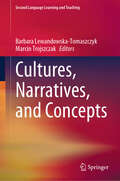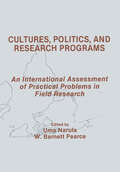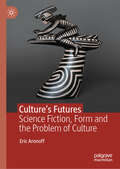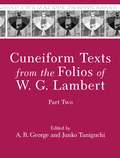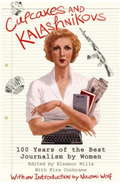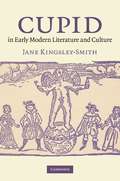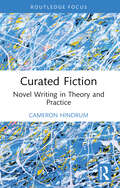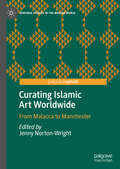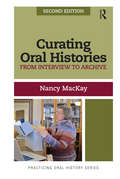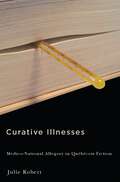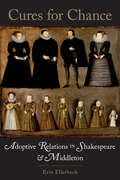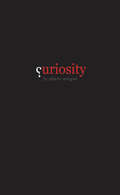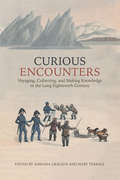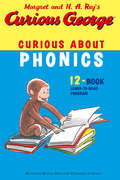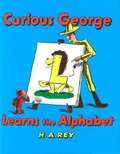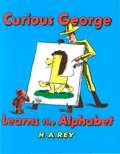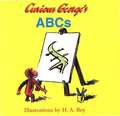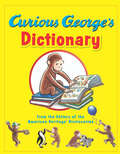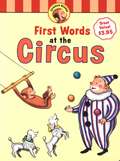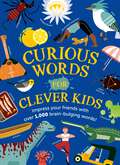- Table View
- List View
Cultures, Narratives, and Concepts (Second Language Learning and Teaching)
by Barbara Lewandowska-Tomaszczyk Marcin TrojszczakThe book presents a wide range of research at the interesection of linguistics and literary studies. Its first part focuses on cultural linguistics and cognitive linguistics, in particular metaphor research. In the second part of the book a set of issues related to cultures and narratives are presented. These include timely discussions on various aspects of discourse ranging from online and media discourse to literary analyses and issues related to AI.
Cultures, Politics, and Research Programs: An International Assessment of Practical Problems in Field Research (Routledge Communication Series)
by Uma Narula W. Barnett PearceA compilation of authoritative reports from seasoned researchers working in eight different countries on five continents, this volume examines the concept that conditions of local feasibility are constitutive of research practices not simply obstructions to the realization of an ideal. The result documents the effects of political and cultural factors on research projects and offers culturally sensitive researchers a wealth of practical knowledge.
Culture’s Futures: Science Fiction, Form and the Problem of Culture
by Eric AronoffThis book argues that science fiction has been a key participant, along with anthropology and literary theory, in the interdisciplinary debates over “culture” and narrative form from the modernist period to the present. Both science fiction and the anthropological ethnography, in their modernist forms and post-modern/postcolonial reinventions, are intertwined technologies for constructing “culture” and difference through narrative worldbuilding. This book traces the ways SF authors -- including Ray Bradbury, Ursula K. Le Guin, and Octavia E. Butler, as well as Indigenous futurists Craig Strete, Celu Amberstone, Rebecca Roanhorse and Cherie Dimaline -- have deployed, interrogated and revised these models of “culture,” representation and power to imagine new futures.
Cuneiform Texts from the Folios of W. G. Lambert, Part Two (Mesopotamian Civilizations #25)
by A. R. George, Junko TaniguchiThis book publishes 323 handcopies of cuneiform tablets found in the academic papers of W. G. Lambert (1926–2011), one of the foremost Assyriologists of the twentieth century. Prepared by A. R. George and Junko Taniguchi, it completes a two-part edition of Lambert’s previously unpublished handcopies.Written by Babylonian and Assyrian scribes in ancient Mesopotamia, the texts collected here are organized by genre and presented with a descriptive catalogue and indexes. The contents include omen literature, divinatory rituals, religious texts, a scribal parody of Babylonian scholarship, theological and religious texts, lexical lists, god lists, and a small group of miscellaneous texts of various genres. The tablets are mainly from the British Museum, but some come from museums in Baghdad, Berlin, Chicago, Geneva, Istanbul, Jerusalem, New Haven, Oxford, Paris, Philadelphia, Tokyo, Toronto, and Washington. In addition, there are copies of eight tablets whose current whereabouts are unknown.This third collection of Lambert’s handcopies published by Eisenbrauns—following Babylonian Creation Myths and Cuneiform Texts from the Folios of W. G. Lambert, Part One—is a crucial part of the intellectual history of the field of Assyriology. In addition, many of these texts are published herein for the first time, making them a valuable and important resource for further study.
Cuneiform Texts from the Folios of W. G. Lambert, Part Two (Mesopotamian Civilizations)
by A. R. George, Junko TaniguchiThis book publishes 323 handcopies of cuneiform tablets found in the academic papers of W. G. Lambert (1926–2011), one of the foremost Assyriologists of the twentieth century. Prepared by A. R. George and Junko Taniguchi, it completes a two-part edition of Lambert’s previously unpublished handcopies.Written by Babylonian and Assyrian scribes in ancient Mesopotamia, the texts collected here are organized by genre and presented with a descriptive catalogue and indexes. The contents include omen literature, divinatory rituals, religious texts, a scribal parody of Babylonian scholarship, theological and religious texts, lexical lists, god lists, and a small group of miscellaneous texts of various genres. The tablets are mainly from the British Museum, but some come from museums in Baghdad, Berlin, Chicago, Geneva, Istanbul, Jerusalem, New Haven, Oxford, Paris, Philadelphia, Tokyo, Toronto, and Washington. In addition, there are copies of eight tablets whose current whereabouts are unknown.This third collection of Lambert’s handcopies published by Eisenbrauns—following Babylonian Creation Myths and Cuneiform Texts from the Folios of W. G. Lambert, Part One—is a crucial part of the intellectual history of the field of Assyriology. In addition, many of these texts are published herein for the first time, making them a valuable and important resource for further study.
Cupcakes and Kalashnikovs: 100 Years Of The Best Journalism By Women
by Naomi Wolf Eleanor MillsMany female journalists came to the fore during the first and second world wars, and their perspective was very different to that of their male peers, who were reporting from the field. Specifically, they often wrote about war from the perspective of those left at home, struggling to keep the household afloat. And with 'How it feels to be forcibly fed' (1914) by Djuna Barnes, one of the world's very first experiential, or 'gonzo' journalists, came a new age of reporting.Since then, women have continued to break new ground in newspapers and magazines, redefining the world as we see it. Many of the pieces here feel almost unsettlingly relevant today -- the conclusions Emma 'Red' Goldman drew in her 1916 'The social aspects of birth control', Maddy Vegtel's 1930s article about becoming pregnant at 40, Eleanor Roosevelt's call for greater tolerance after America's race riots in 1943. Many have pushed other limits: Naomi Wolf's Beauty Myth brought feminism to a new generation; Helen Fielding's Bridget Jones caused a media revolution; Ruth Picardie's unflinchingly honest column about living with cancer in 1997 brought a wave of British candour and a host of imitators; and when two iconic women come face to face, we have at one end Dorothy Parker on Isadora Duncan (1928) and at the other Julie Burchill on Margaret Thatcher (2004). This collection of superlative writing, selected by the Sunday Times's most senior female editor, brings together the most influential, incisive, controversial, affecting and entertaining pieces of journalism by the best women in the business. Covering: War; Crime; Politics & Society; Sex & Romance; Body Image & Health; Family, Friendship & Birth; Emancipation & Having it All; Hearth & Home; Icons & Interviews. Including: Lynn Barber, Djuna Barnes, Julie Burchill, Angela Carter, Marie Colvin, Jilly Cooper, Joan Didion, Margaret Drabble, Helen Fielding, Zelda Fitzgerald, Kathryn Flett, Martha Gellhorn, Nicci Gerrard, Emma Goldman, Germaine Greer, Nicola Horlick, Erica Jong, Jamaica Kincaid, India Knight, Christina Lamb, Daphne du Maurier, Nancy Mitford, Suzanne Moore, Camille Paglia, Sylvia Pankhurst, Dorothy Parker, Allison Pearson, Ruth Picardie, Erin Pizzey, Eleanor Roosevelt, Zadie Smith, Susan Sontag, Gloria Steinem, Martha Stewart, Mary Stott, Jill Tweedie, Rebecca West, Zoe Williams, Jeanette Winterson, Naomi Wolf.
Cupcakes and Kalashnikovs: 100 years of the best Journalism by women
by Eleanor MillsMany female journalists came to the fore during the first and second world wars, and their perspective was very different to that of their male peers, who were reporting from the field. Specifically, they often wrote about war from the perspective of those left at home, struggling to keep the household afloat. And with 'How it feels to be forcibly fed' (1914) by Djuna Barnes, one of the world's very first experiential, or 'gonzo' journalists, came a new age of reporting.Since then, women have continued to break new ground in newspapers and magazines, redefining the world as we see it. Many of the pieces here feel almost unsettlingly relevant today -- the conclusions Emma 'Red' Goldman drew in her 1916 'The social aspects of birth control', Maddy Vegtel's 1930s article about becoming pregnant at 40, Eleanor Roosevelt's call for greater tolerance after America's race riots in 1943. Many have pushed other limits: Naomi Wolf's Beauty Myth brought feminism to a new generation; Helen Fielding's Bridget Jones caused a media revolution; Ruth Picardie's unflinchingly honest column about living with cancer in 1997 brought a wave of British candour and a host of imitators; and when two iconic women come face to face, we have at one end Dorothy Parker on Isadora Duncan (1928) and at the other Julie Burchill on Margaret Thatcher (2004). This collection of superlative writing, selected by the Sunday Times's most senior female editor, brings together the most influential, incisive, controversial, affecting and entertaining pieces of journalism by the best women in the business. Covering: War; Crime; Politics & Society; Sex & Romance; Body Image & Health; Family, Friendship & Birth; Emancipation & Having it All; Hearth & Home; Icons & Interviews. Including: Lynn Barber, Djuna Barnes, Julie Burchill, Angela Carter, Marie Colvin, Jilly Cooper, Joan Didion, Margaret Drabble, Helen Fielding, Zelda Fitzgerald, Kathryn Flett, Martha Gellhorn, Nicci Gerrard, Emma Goldman, Germaine Greer, Nicola Horlick, Erica Jong, Jamaica Kincaid, India Knight, Christina Lamb, Daphne du Maurier, Nancy Mitford, Suzanne Moore, Camille Paglia, Sylvia Pankhurst, Dorothy Parker, Allison Pearson, Ruth Picardie, Erin Pizzey, Eleanor Roosevelt, Zadie Smith, Susan Sontag, Gloria Steinem, Martha Stewart, Mary Stott, Jill Tweedie, Rebecca West, Zoe Williams, Jeanette Winterson, Naomi Wolf.
Cupid in Early Modern Literature and Culture
by Jane Kingsley-SmithCupid became a popular figure in the literary and visual culture of post-Reformation England. He served to articulate and debate the new Protestant theory of desire, inspiring a dark version of love tragedy in which Cupid kills. But he was also implicated in other controversies, as the object of idolatrous, Catholic worship and as an adversary to female rule: Elizabeth I's encounters with Cupid were a crucial feature of her image-construction and changed subtly throughout her reign. Covering a wide variety of material such as paintings, emblems and jewellery, but focusing mainly on poetry and drama, including works by Sidney, Shakespeare, Marlowe and Spenser, Kingsley-Smith illuminates the Protestant struggle to categorise and control desire and the ways in which Cupid disrupted this process. An original perspective on early modern desire, the book will appeal to anyone interested in the literature, drama, gender politics and art history of the English Renaissance.
Curated Fiction: Novel Writing in Theory and Practice
by Cameron HindrumCurated Fiction presents a new theory and methodology for developing, drafting and refining creative writing. At the intersection of literary studies and creative writing, this book develops a new theory for analysing how novelists use narrative point-of-view to direct readers’ trust.The book defines the parameters and practice of one possible approach to the creative development of a work of long-form fiction. The value underpinning this approach will be drawn from the theories that inform it, such as Irene Kacandes’s work on Talk Fiction, Bakhtinian concepts of polyphony and Gerald Prince’s concept of the Disnarrated.Offering critical analyses of existing literary works, such as Waterland and As I Lay Dying, Curated Fiction will afford examination of theory in practice, in differing literary forms and contexts before making practical connections with the craft of writing through the analysis of an original short story, 'Foxes'.
Curating Islamic Art Worldwide: From Malacca to Manchester (Heritage Studies in the Muslim World)
by Jenny Norton-WrightThis volume gives voice to cultural institutions working with collections of Islamic art and material culture globally, including many from outside Western Europe and North America. The contributions inform a vibrant, ongoing global conversation around curatorship in this field, one that embraces the responsibilities, challenges and opportunities for those engaged in it. Contributors—including art historians, curators and education specialists—discuss curatorial methodologies in theoretical and practical terms, present new exhibitions of Islamic art and culture, and explore the role of educational and engagement practices related to Islamic collections and Muslim audiences.
Curating Oral Histories: From Interview to Archive (Practicing Oral History #2)
by Nancy MacKayFor the past ten years, Nancy MacKay’s Curating Oral Histories (2006) has been the one-stop shop for librarians, curators, program administrators, and project managers who are involved in turning an oral history interview into a primary research document, available for use in a repository. In this new and greatly expanded edition, MacKay uses the life cycle model to map out an expanded concept of curation, beginning with planning an oral history project and ending with access and use. The book:-guides readers, step by step, on how to make the oral history “archive ready”;-offers strategies for archiving, preserving, and presenting interviews in a digital environment;-includes comprehensive updates on technology, legal and ethical issues, oral history on the Internet, cataloging, copyright, and backlogs.
Curative Illnesses
by Julie RobertDuring a time of uncertainty over collective identity and social transformation, Quebec novels started getting sick - after 1940, the number of narratives about illness, disease, and sick characters intensified. For the last seventy years, generations of authors have turned to medically oriented stories to represent day to day life and political turmoil. In Curative Illnesses, Julie Robert investigates how the theme of sickness is woven into literature and gauges its effect on depictions of Quebec's national identity. Challenging the legitimacy of illness as a metaphor for the nation, Robert contests interpretations of illness-related literature that have presented Quebec itself as ailing. Through re-examinations of Quebec novels, Curative Illnesses shatters the illusion of congruency between the nation and the body, countering assumptions about nationwide weakness and victimization. For Quebec in particular, these assumptions have greater implications, because the separatist movement, policies of interculturalism, and majority language rights revolve around protecting and defending Québécois society and its cultural values. Robert skilfully demonstrates a more nuanced view of illness through a series of analyses focusing on works of literature from some of Quebec's most renowned novelists, including Gabrielle Roy, André Langevin, Denis Lord, Hubert Aquin, Jacques Godbout, Pierre Billon, and Anne Bernard. Using an interdisciplinary approach that engages with nationalism, postcolonial studies, literature, rhetoric, and the medical humanities, Curative Illnesses explores how moving beyond earlier diagnoses offers new insights into nationhood.
Curative Illnesses: Medico-National Allegory in Québécois Fiction
by Julie RobertA necessary second opinion on the national implications of an epidemic of sick literary characters.
Cures for Chance: Adoptive Relations in Shakespeare and Middleton
by Erin EllerbeckAdoption allows families to modify, either overtly or covertly, what is considered to be the natural order. Cures for Chance explores how early modern English theatre questioned the inevitability of the biological family and proposed new models of familial structure, financial inheritance, and gendered familial authority. Because the practice of adoption circumvents sexual reproduction, its portrayal obliges audiences to reconsider ideas of nature and kinship. This study elucidates the ways in which adoptive familial relations were defined, described, and envisioned on stage, particularly in the works of Shakespeare and Middleton. In the plays in question, families and individual characters create, alter, and manage familial relations. Throughout Cures for Chance, adoption is considered in the broader socioeconomic and political climate of the period. Literary works and a wide range of other early modern texts – including treatises on horticulture and natural history and household and conduct manuals – are analysed in their historical and cultural contexts. Erin Ellerbeck argues that dramatic representations of adoption test conventional notions of family by rendering the family unit a social construction rather than a biological certainty, and that in doing so, they evoke the alteration of nature by human hands that was already pervasive at the time.
Curiosity
by Alberto ManguelCuriosity has been seen through the ages as the impulse that drives our knowledge forward and the temptation that leads us toward dangerous and forbidden waters. The question "Why?" has appeared under a multiplicity of guises and in vastly different contexts throughout the chapters of human history. Why does evil exist? What is beauty? How does language inform us? What defines our identity? What is our responsibility to the world? In Alberto Manguel's most personal book to date, the author tracks his own life of curiosity through the reading that has mapped his way. Manguel chooses as his guides a selection of writers who sparked his imagination. He dedicates each chapter to a single thinker, scientist, artist, or other figure who demonstrated in a fresh way how to ask "Why?" Leading us through a full gallery of inquisitives, among them Thomas Aquinas, David Hume, Lewis Carroll, Rachel Carson, Socrates, and, most importantly, Dante, Manguel affirms how deeply connected our curiosity is to the readings that most astonish us, and how essential to the soaring of our own imaginations.
Curious Baby My First Words at the Farm Gift Set (Curious George Book & Hat)
by H. A. ReyA gingham-patterned gift box includes a board book and cotton monkey-ear hat for keeping curious babies warm and cozy. The board book features lively illustrations of Curious George exploring the farm. Each object and animal includes a simple label. The gift package incorporates tips for new parents about the importance of shared reading. Pair this with the Curious Baby Curious George: My Curious Dreamer Gift Set for a cuddly, soft reading experience with your baby.
Curious Encounters: Voyaging, Collecting, and Making Knowledge in the Long Eighteenth Century (UCLA Clark Memorial Library Series)
by Mary Terrall Adriana CraciunWith contributions from historians, literary critics, and geographers, Curious Encounters uncovers a rich history of global voyaging, collecting, and scientific exploration in the long eighteenth century. <P><P>Leaving behind grand narratives of discovery, these essays collectively restore a degree of symmetry and contingency to our understanding of encounters between European and Indigenous people. To do this the essays consider diverse agents of historical change, both human and inanimate: commodities, curiosities, texts, animals, and specimens moved through their own global circuits of knowledge and power. <P><P>The voyages and collections rediscovered here do not move from a European center to a distant periphery, nor do they position European authorities as the central agents of this early era of globalization. Long distance voyagers from Greenland to the Ottoman Empire crossed paths with French, British, Polynesian, and Spanish travelers across the world, trading objects and knowledge for diverse ends. <P><P>The dynamic contact zones of these curious encounters include the ice floes of the Arctic, the sociable spaces of the tea table, the hybrid material texts and objects in imperial archives, and the collections belonging to key figures of the Enlightenment, including Sir Hans Sloane and James Petiver.
Curious George Curious About Phonics 12 Book Set (Read-aloud)
by H. A. ReyThe Curious About Phonics Learn-to-Read program can help your child master the basic phonics skills that are the building blocks for a lifetime of reading and learning. These twelve books introduce a carefully selected progression of letter sounds; there are repeated examples of the sounds being focused on, and high-frequency words (the, and) are called out, as are challenge words (rabbit, pancake). Challenge words are always referenced in the art. Also included with the set is a handy parent guide. The audio for this Read-Aloud ebook was produced and engineered by Perry Geyer at Cybersound Recording Studios (349 Newbury St., Ste. 201, Boston, MA 02115). Music theme composed by Cybersound Studios (Perry Geyer, Silvio Amato, Michael Africk, Greg Hawkes). Engineers: Perry Geyer (music production and sound design), Rob Whitaker (editing and mixing engineer), Samuel Creager (editing, sound design, and mixing engineer), Marcus Clark, Corey Rupp. Assistant engineers: Dave Chapman, Mike Pekarski, Justin Sheriff, Daniel Wrigley, Andrew Sardinha, Mami Ienaga, Kevin Notar, Maria Goulamhoussen. Sheridan Willard, John Huang, John Schmidt. Voiceover by Joyce Kulhawik.
Curious George Learns the Alphabet
by H. A. ReyReaders learn the alphabet along with George as the man in the yellow hat teaches the curious monkey how to read.
Curious George Learns the Alphabet
by H. A. Rey Margret ReyReaders learn the alphabet along with George as the man in the yellow hat teaches the curious monkey how to read.
Curious George's ABCs
by H. A. ReyRead from A to Z along with George in a condensed version of the clas-sic Curious George Learns the Alphabet.
Curious George's Dictionary (Curious George)
by The Editors of the American Heritage DictionariesCurious George gets curious about words in this illustrated dictionary designed for children from preschool through kindergarten. In an illustrated introduction to this unique dictionary, Curious George learns how to look up words before embarking on an educational adventure through a vocabulary list chosen specifically for children ages four to six. The dictionary itself presents approximately 600 words, with six words to a page. Each entry is illustrated with a full-color drawing, and more than half of the illustrations include a sample sentence that puts the word in context. At the end of the book, eight full-page features present groups of thematically related words such as colors, shapes, and numbers.
Curious George's First Words at the Circus
by H. A. ReyEach of these well-priced ebooks introduces readers to a new, fun location and identifies objects they might find there. These ebooks will build children's vocabulary as they follow Curious George on his trips to the zoo, circus, circus, aquarium, and farm. Bold colors, large type, and everyone's favorite mischievous monkey combine to make learning fun.
Curious Words for Clever Kids
by Sarah CraiggsTake an illustrated ride through the wonderful world of curious words. Have you ever wondered what an Indri is, eaten a Clapshot, grown a Cloudberry or come across a Colugo? Do you always find yourself looking up CURIOUS WORDS? From Nefarious and Knots to Yuzus and Yews, this brilliant tour through over 1,000 wonderful words and their meanings, packed with awesome illustrations is the perfect book for kids who always want to know what EVERYTHING means!Colourful pages burst with curious words on subjects from space and dinosaurs to colours and actions, while language spreads explain how different types of words can do what you want them to do.
